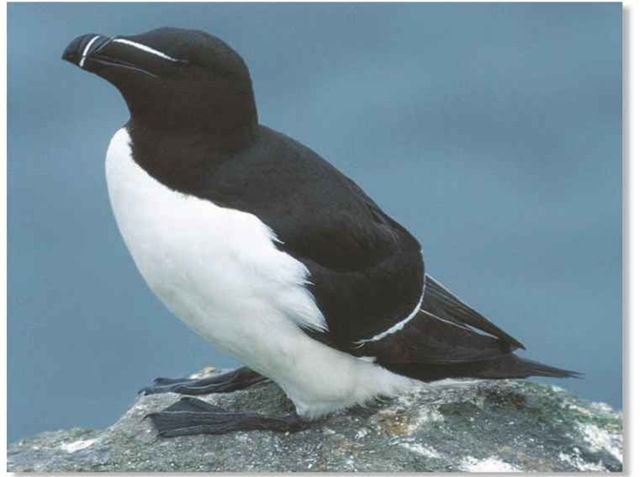ORDER
Charadriiformes
FAMILY
Alcidae
GENUS & SPECIES
KEY FEATURES
• Propels through air or water with equal flair; a master flier, swimmer and diver
• Spreads feet, wings and tail in an awkward posture when braking for quick stops on narrow cliff ledges
WHERE IN THE WORLD!
Found in the boreal and sub-Arctic waters of the Atlantic; breeds on cliffs and islands in Scotland, France, Norway, Canada and Maine

Lifecycle
A champion of action, the razorbill swims, dives and flies with expertise; on land, it spends a large part of its day socializing with other razorbills on jagged cliff edges.
HABITAT
For most of the year, the razorbill, a pelagic (ocean-going) bird, spends its time in the icy waters of the north Atlantic. In the spring it returns to steep cliffs on the mainland and offshore islands to breed. Thousands of razorbills join a multitude of puffins, petrels and other birds on the steep inclines. There’s room for all, since each species prefers a different type of nesting site on the almost perpendicular slopes. Razorbills choose broad projections or sheltered crevices for their nests, in an attempt to avoid the dangers of sun, wind and predatory gulls. These midlevel ledges still provide access to the sea for chicks, which leave the nest before they can fly.
Club razorbill
Adult and immature razorbills lounge about on large, flat outcrops on high cliffs above the nesting sites.
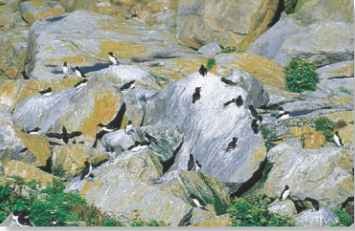
The razorbill remains submerged for about 22 seconds during a dive, but can stay underwater for a maximum of 52 seconds.
To establish a strong bond, a pair of razorbills will occasionally copulate up to 80 times during the month before egg laying.
FOOD & FEEDING
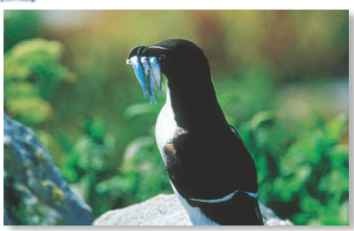
The razorbill can dive to 300′ or more, but usually finds its food within depths of 9-75′ in the boreal seas. Hoping to catch more than one fish per dive, the razorbill often dips its head into the water a few times to scout for prey before diving. With a flick of its feet, the razorbill up ends and dives, hunting mainly for sand eels — but gobies, sardines, anchovies and herrings also make tasty meals. When gathering food for its chick, the razorbill gathers up to 20 fish crosswise in its bill before heading back to the nest.The razorbill has also been seen robbing puffins of their catch, both in the air and during underwater chases.
After a winter at sea, razorbill pairs usually reunite. At congregating areas on the cliff, they strengthen their bond, nibbling bills and preening feathers. At sea, they “water dance,” swimming around one another Mating takes place just weeks before egg-laying, so the birds don’t bother making a nest. The female simply lays her one egg directly on the rock crevice before settling to incubate for about 35 days, occasionally tucking a small stone below herto help keep the egg in place.The male relieves her at least twice a day to feed, socialize or roost idly at sea. He trades places with her after tickling her neck.
Within hours of birth, the hungry chick taps on the distinct white bar across its parents’ bill to beg for food. Both parents feed the chick and shelter it for 2 weeks, until the young chick is ready to leave the nest, but not quite ready to fly. After sunset, it dives off the high cliff into the water, followed by its father, who accompanies the chick at sea, until it’s able to fly. The chick will remain at sea until it is 2-3 years of age, when it will join adults as an observer at the cliff-side nesting sites.
SEA HUNT
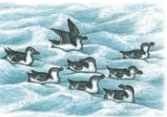
A floating raft…
Turbulent waters make floating together difficult.The razorbills, at sea for the winter, search for food through the dark waves.
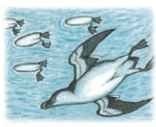
An expert dive…
One bird spots a potential snack and descends with a powerful dive, coordinating wings, feet and tail for expert maneuvering.
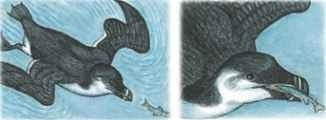
In hot pursuit…
The razorbill “flies” through the water with rapid wing beats and, reaching a depth of 15′, closes the gap between bird and prey.
A selfish snack
Without a chick to feed, the razorbill keeps the treat. It swallows the fish whole, while keeping an eye out for more.
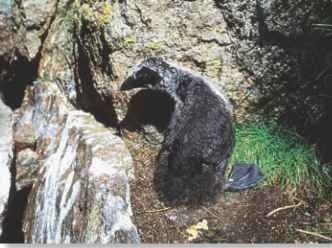
A No BABYSITTER
The parents trust that the boulder will hide their chick until they return with food.
BEHAVIOR
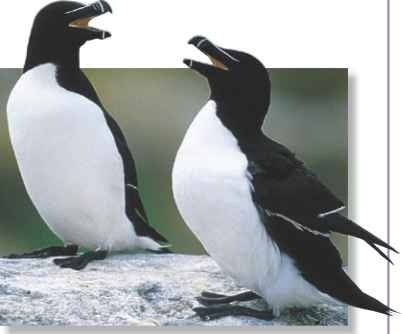
A Meeting place Razorbills are very sociable when breeding.
The ease and speed with which razorbills swim resembles that of penguins. But, unlike penguins, the razorbill can fly. Launching
from its perilous nesting ledge, the bird flaps its wings slowly in a glide to sea level.Then, rapidly beating its pointed wings, the razorbill flies over the cool waters with tail and feet stretched behind for added lift. When returning to land, the razorbill often flies over the landing site a few times for inspection before touchdown. It sweeps upward slightly to decelerate and spreads its wings, tail and feet in an awkward-looking braking posture.
On land, razorbills spend their time at the nest or at areas nearby called clubs.They are highly social when breeding; birds from two or three nesting groups may associate at the gathering area.
CONSERVATION
Inaccessibility prevents an accurate tally of the number of razorbills, though estimates reach as high as 2.5 million. The birds benefit from their remoteness, but oil spills and fishing nets have caused recent declines. Listed as threatened by the state of Maine, they are also protected on the Gannet Islands ecological preserve, the largest colony in eastern North America.
PROFILE
Razorbill
With speed and skill, the razorbill cuts through the air or water with a sleek body designed for flying, swimming and even diving to depths of over 300′.

CREATURE COMPARISONS
The common murre, or guillemot (Uria aalge), is one of the largest members of the alcid family, weighing up to 32 oz. and measuring 16″ tall. Very similar to the razorbill in appearance, the murre has a thinner; longer and shorter tail. Coloring also distinguishes the birds in the water or at their cliff-side nests. Murres are blackish-brown, whereas razorbills are a darker black. With ranges similar to the razorbill, the murre selects narrow rock ledges and lays slightly oblong eggs, which are shaped to roll in circles, so as not to roll off the small ledge. The razorbill picks wider ledges at the same cliffs and lays oval eggs that roll straighter
| VITAL STATISTICS Weight 28 oz. |
|
| Length | 14-17″ |
| Wingspan | 24-27″ |
| Sexual Maturity | 4-5 years |
| Breeding Season | April-June |
| Number Eggs | 1 |
| Incubation Period | 35-37 days |
| Fledging Period | 16-28 days |
| Breeding Interval | 1 year |
| Typical Diet | Fish and aquatic vertebrates |
| Lifespan | 20 years |
RELATED SPECIES
• Razorbills and murres, members of the Alcidae family, join terns and gulls in the order Charadriiformes. A relative of the puffin, the razorbill is closely related to the extinct flightless great auk. Because of its dense feathers and great skill in the water, the razorbill is often compared to the flightless penguins (Sphenisciformes) of the Antarctic, but they are in different orders.
